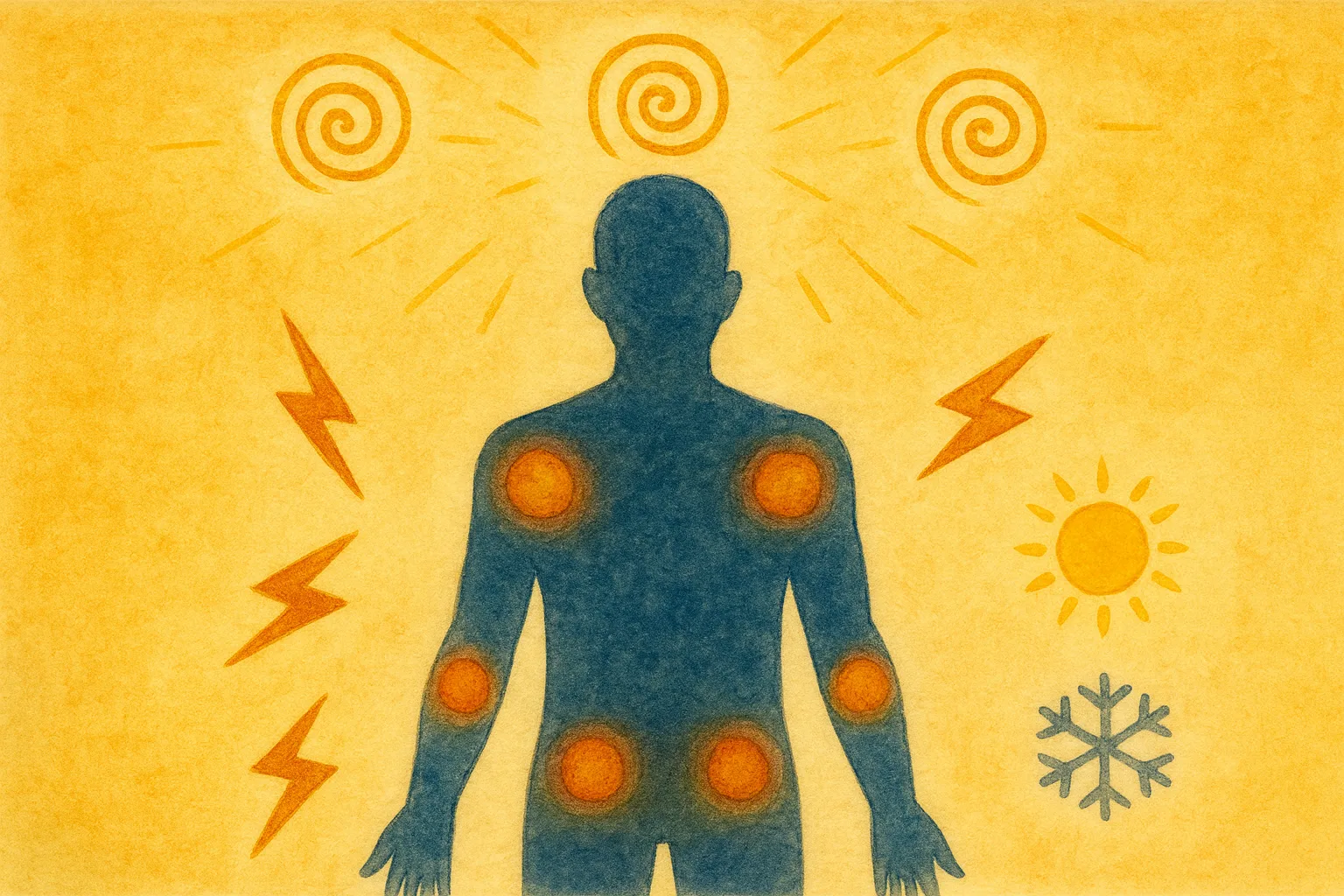I’ve already talked about the five main senses (hearing, sight, touch, smell, taste), but the human body has several others — most notably four: the vestibular system, proprioception, nociception, and thermoception. The last one you know well: it’s the reason you turn into an ice cube in winter and a boiling pot in summer. In autistic people, these senses are often altered in the same way as the five primary ones. Yet these so-called invisible senses shape our everyday experience. When they are atypical — as is often the case in autism — they can turn ordinary situations into a full emotional and sensory rollercoaster.
📋 TL;DR : My sensitivities in a few words
- Proprioception: clumsiness (breakage, bumping into things), tight hugs are calming.
- Vestibular system: motion sickness and dizziness, yet seeking intense physical sensations.
- Nociception: light touch feels painful, but injuries sometimes go unnoticed.
- Thermoception: low sensitivity to cold, yet very hot showers and heat are well tolerated.
- Interoception: hunger and thirst are hard to detect, heartbeat difficult to feel.
🚶 Proprioception
This sense (often referred to as the “sixth sense”) allows us to know where our body is in space without needing to look at it.
A bit of science
Proprioception enables us to sense the position of our body in space without visual input. It relies on mechanosensory receptors located in the muscles, tendons, and joints (see Wikipedia). These receptors detect movement, stretching, and positioning.
They work together with vision and the vestibular system (our sense of balance). The information sent by these receptors builds an internal map of the body in motion.
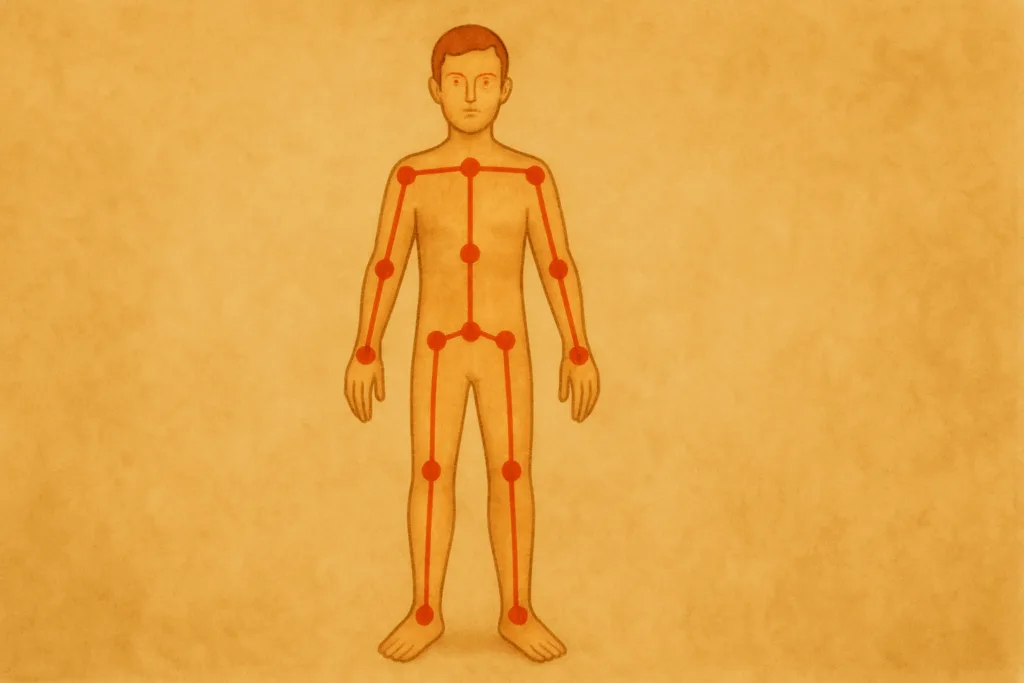
And what about me?
In autism, proprioception is often atypical in similar ways from one person to another. A common example is clumsiness. I also perceive the texture of certain foods very strongly (especially meat or fish of any kind), which makes chewing unbearable — and going to restaurants complicated in countries where meat-free options are almost nonexistent. I’m mainly hyposensitive in this area. If I try to touch my nose with my eyes closed, I’ll almost certainly touch my eye or my mouth instead. I regularly break dishes or drop objects. I’m also dyspraxic, which is strongly linked to difficulties with proprioception. At the same time, I’ve mentioned that I only enjoy hugs when they’re very tight — another example of sensory under-responsiveness and a search for deep pressure to activate the receptors.

Some of these traits are also linked to hyposensitivity in the vestibular system.
🎢 The vestibular system
This is the sense that regulates our balance and perception of movement. It is located in the inner ear. What makes you motion-sick on a winding mountain road or on a rough sea is the vestibular system at work.
A bit of science
The vestibular system is connected to the cochlea (the organ responsible for hearing), which is why ear infections or hearing issues can affect balance (see Inserm — Hearing tests and vertigo). It is made up of two types of sensory receptors:
- The semicircular canals, which detect angular and rotational movements of the head
- The otolithic organs, which detect linear movement (like a car accelerating) and gravity
Specialized cells convert the information received from these receptors into electrical signals, which are then integrated with vision and proprioception. When the system malfunctions, it can cause various issues such as dizziness or involuntary eye movements. To keep this article readable, I’ll stop the scientific explanation here.
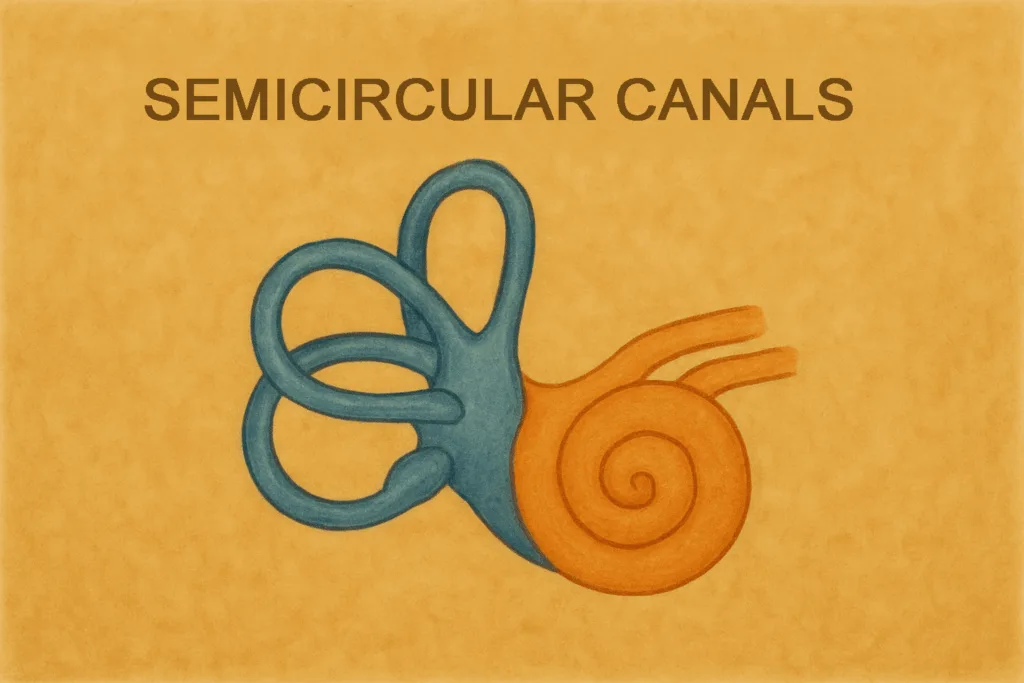
And what about me?
When I was younger, I was often very sick in the car. Since I spent my teenage years in Guadeloupe on Basse-Terre (the mountainous western part of the island), car rides were often a nightmare. We also sometimes travelled to one of the nearby islands (Les Saintes), which required about an hour by boat. I always stayed on the upper deck to get fresh air — and still vomited as soon as I got off. Even when the sea was calm.
In fact, the bigger the boat, the sicker I became. It sounds counterintuitive, but it’s actually simple: motion sickness happens when there’s a mismatch between the vestibular system (which senses movement), vision (which sees a stable horizon), and proprioception (which tells me I’m still). The brain interprets this conflicting information as a toxic signal — and triggers nausea as a protective response.
I also frequently had trouble during flights. Now, I always carry sick bags with me just in case — even though I’ve gradually desensitized myself over time.
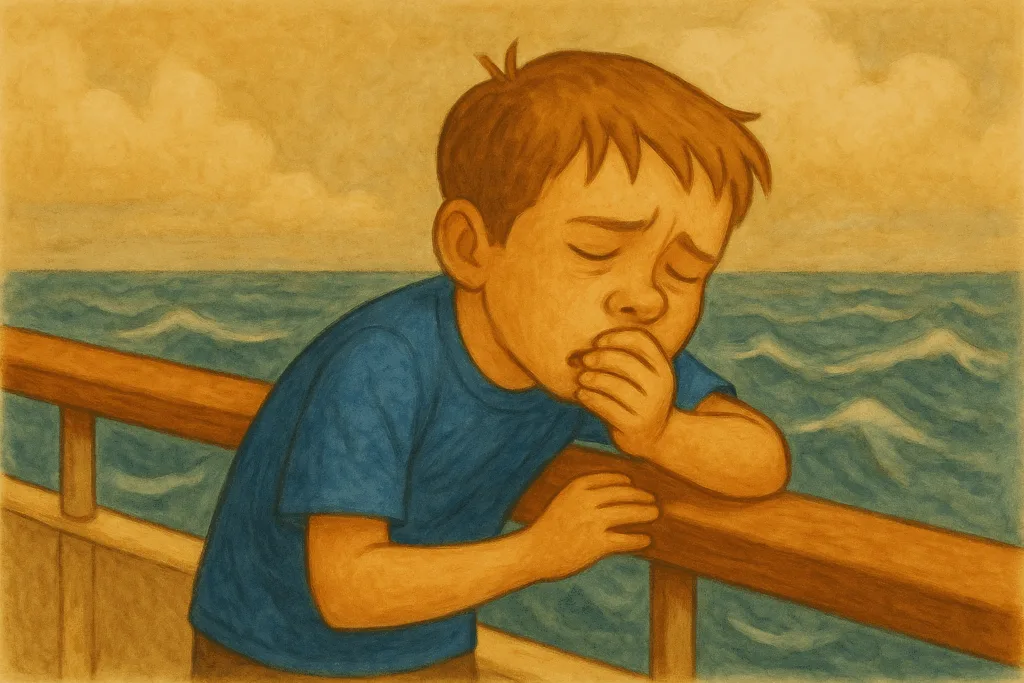
In contrast, I often seek vestibular stimulation. I love roller coasters—especially the intense ones—I walk so fast people think I’m on a mission (which forces me to slow down when I’m with others), and I’m almost always rocking or swaying. I also mentally simulate movement-based scenes, which shows that my brain actively seeks motion.
⚡ Nociception
A bit of science
Without going too deep into the biology, nociception is the process through which the nervous system detects potentially harmful stimuli (like burns or injury). It’s not the same as pain — pain is the brain’s interpretation of the warning signals sent by nociceptors. These receptors are located in the skin, muscles, and joints.
Nociceptors determine where and how intense the stimulus is, and they also trigger the unpleasant emotional component of pain. They’re responsible for protective reflexes as well — like pulling your hand away from something hot. This article from CNI covers this in more detail for readers who want a scientific deep dive.
And what about me?
Just like with the previous senses, atypical nociception is often observed in autism — most commonly hyposensitivity. That’s what research long suggested. However, some newer studies propose the opposite: heightened sensitivity to pain, but less visible because autistic people may express it differently. In some cases, pain sensitivity fluctuates depending on the body area.
I have vivid memories of frequent, excruciating ear infections as a child, yet I could injure myself rollerblading without noticing. The same applies to scratches. On the other hand, PCR tests (which I’ve had to do repeatedly due to hospitalizations) send my body into full alert — the sensation is sharply painful and lingers far longer for me than for my allistic friends.
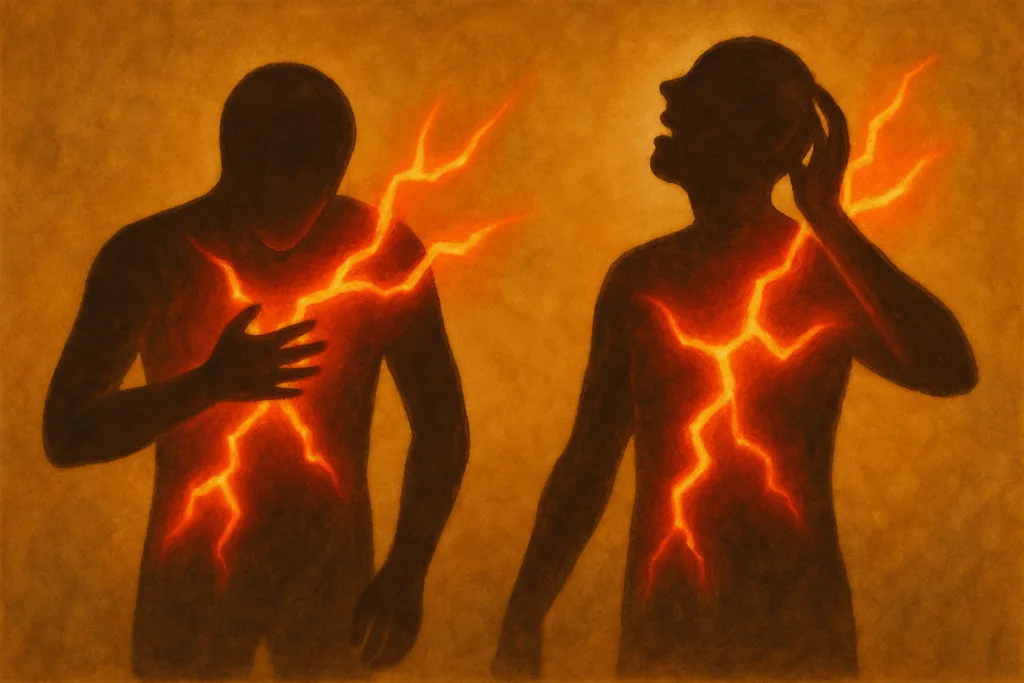

I also experience light touch as a real intrusion and pain (especially on certain parts of my body such as my legs or lower torso), while paradoxically spending years punching walls during meltdowns — autistic crises — as a way of seeking a strong, controlled stimulus to feel something. I’ll come back to these crises in a future article, but the pain from hitting the wall was more bearable than the intensity of the meltdown. It was my way of externalizing what was overwhelming me.
🌡️ Thermoception
And finally, a few words about the sense responsible for perceiving temperature.
A bit of science
While nociception warns us of potential danger, thermoception simply provides the brain with information about the thermal environment to allow adaptation (ScienceDirect — Thermoception). It’s what helps us detect when we need a sweater or to cover ourselves, and what protects us from heat. On a physiological level, thermoception is what allows the brain to adjust sweating, blood circulation, and shivering to maintain stable body temperature — though this becomes more challenging in extreme temperatures. Thermoception applies only to non-painful temperature sensations. Once the threshold of harm is crossed, nociception takes over.
And what about me?
In my case, I’m mostly hyposensitive to temperature. That hasn’t always been true. My high heat tolerance has stayed consistent over time. I’ve always taken, and still take, very hot showers or baths, so hot that people after me often describe them as burning (my family suffered through this for years). Living in Guadeloupe or in very hot, humid climates has never been a problem for me.

In contrast, my relationship with cold has changed—mostly because of my autistic burnout. Moving to Paris after living for twelve years in a climate where temperatures rarely dropped below 18°C was extremely difficult. I was so sensitive that I felt freezing cold in temperatures Parisians considered normal. Add to that the difficulty of sensing when I should start wearing a coat, and you get a perfect recipe for turning me into a walking icicle.
The burnout drastically changed this relationship with cold: I can now go outside in temperatures below 10°C wearing just a T-shirt without realizing how cold it is. And since I walk fast, the proprioceptive and vestibular feedback is enough stimulation to warm me up. But even if I don’t feel the cold, my body still reacts to it (shivering, runny nose, etc.). So I now check the weather before leaving and dress accordingly (IF temperature < 15°C = sweater, IF temperature < 5°C = coat).
It usually works — though fatigue can affect my sensitivity and make the system unreliable.

Burnout only made me particularly hyposensitive to cold. The other senses I mentioned weren’t affected — or at least not in a way I’ve noticed so far. However, my bipolar episodes have a much stronger influence on each of these senses, and I’ll talk about that in a separate article to keep this one lighter.
❤️ And what about interoception?
A few words about this sense, which allows us to perceive internal bodily signals — with mechanisms that continuously adjust our perception threshold in real time, as demonstrated by this study. Interoception can also be affected in autism. In my case, I’m partly hyposensitive.
It’s the sense that allows us to detect hunger, thirst, or our heartbeat. These are signals my brain often fails to register. Feeling my heart beating faster than usual — for example to detect anxiety — is nearly impossible. I also struggle to feel hunger and need to deliberately remind myself to drink water, especially in summer when I neither feel heat nor the increased need for hydration.
TL;DR : My sensory issues
🚶 Proprioception:
- Hypersensitivities:
- Chewing meat, fish, or seafood: unbearable — avoided
- Standing still in one position: difficult — constant shifts in posture
- Hyposensitivities:
- Dyspraxia:
- Clumsiness:
- I often drop objects
- I spill bottles
- I break dishes
- I bump into furniture — or even walls
- Clumsiness:
- Fine motor skills (writing, scissors): difficult
- Tight hugs: sought out for pressure
- Weighted blanket (filled with glass beads): calming
- Touching my nose with my index finger, eyes closed: impossible
- Dyspraxia:
🎢 Vestibular system:
- Hypersensitivities:
- Motion sickness (boat, car, plane)
- Walking on unstable ground: overwhelming
- Heights: intense discomfort
- Walking in the dark: no visual reference → loss of balance
- Hyposensitivities:
- Roller coasters: euphoria
- Rocking side to side: constant
- Walking fast as if on a “mission”
- Mentally simulating movement-based scenes: soothing
- Climbing trees: pleasant sensation
⚡ Nociception :
- Hypersensitivities:
- Gentle touch on certain areas: painful
- Light contact: overwhelming, aggressive
- Dentist visits (even with strong anesthesia): unbearable
- Ear infections (and ear-cleaning tools): extremely painful
- Hyposensitivities:
- Scratches or cuts: barely noticeable
- Sports injuries: often unnoticed — detected late
- Hitting my head with my hands: sensory regulation during meltdowns
🌡️ Thermoception :
- Hypersensitivities:
- Cold water on skin: almost painful — avoided (If I have no access to hot water, I can go several days without showering — I’m currently forcing myself to shower while writing this article.)
- Hyposensitivities:
- Very hot environments: sought out
- Very cold environments: barely noticed — forget to dress accordingly
- Scalding water: noticed late
- Almost burning-hot shower: soothing
Originally published in French on: 7 Sep 2025 — translated to English on: 18 Nov 2025.

